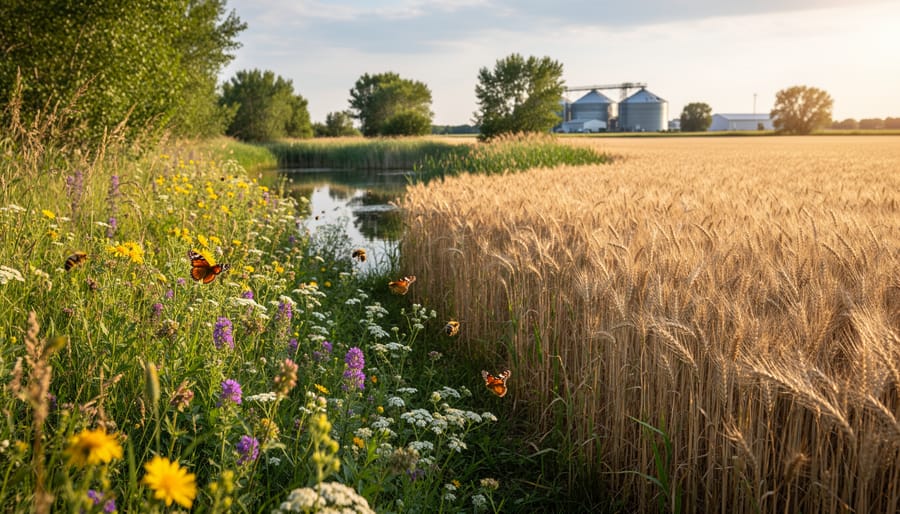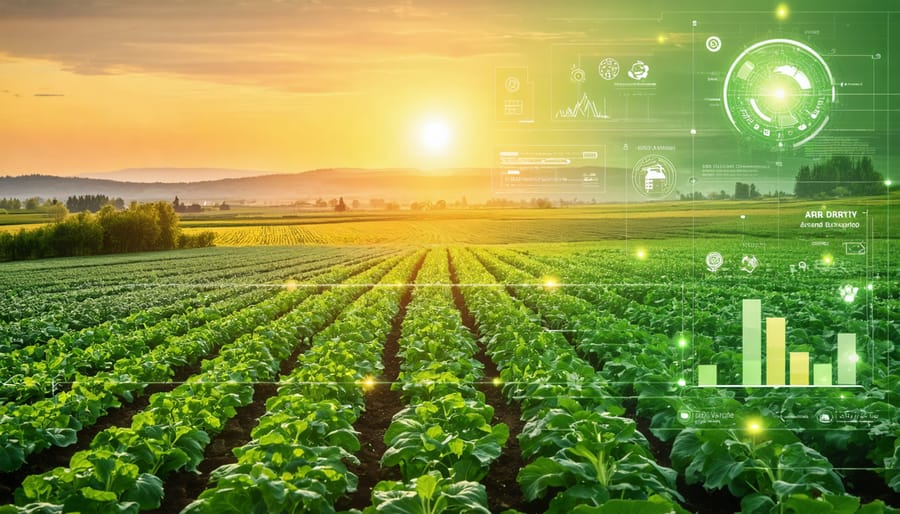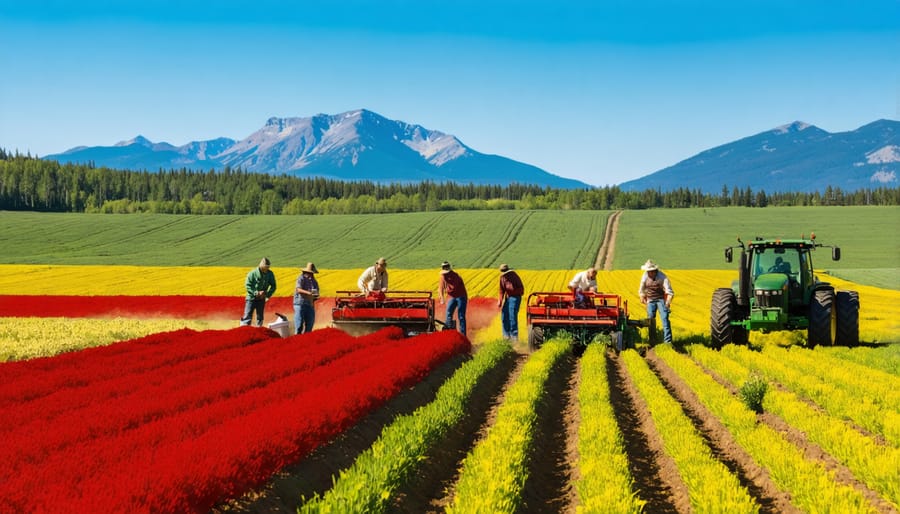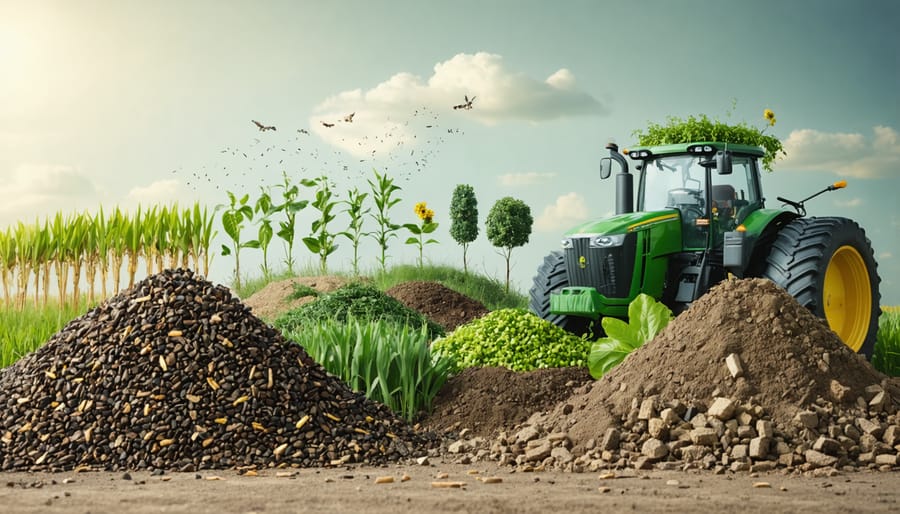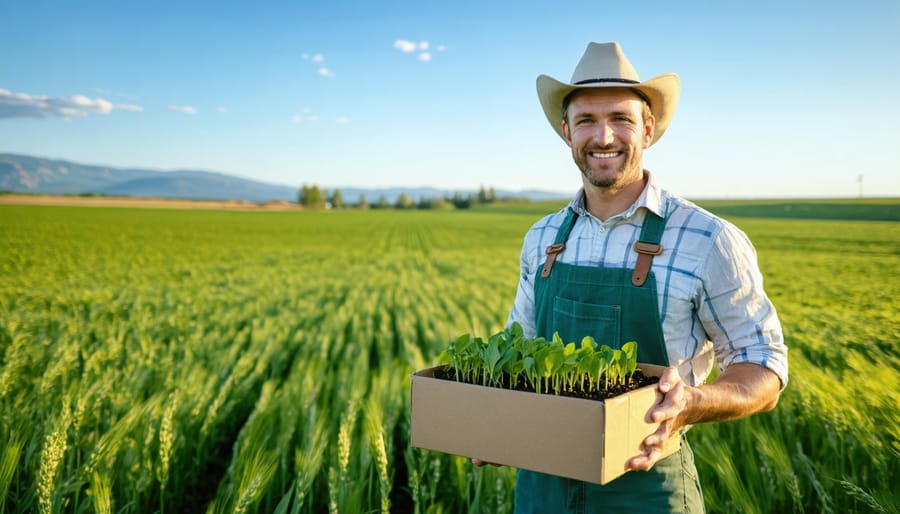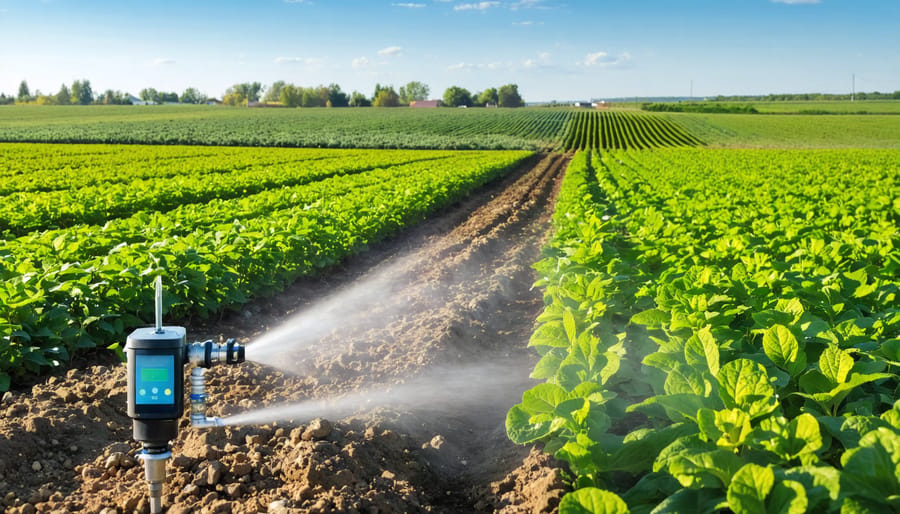Artificial intelligence is revolutionizing sustainable agriculture across Alberta’s heartland, transforming how we monitor crop health, manage water resources, and reduce environmental impact. From precision farming in Lethbridge’s irrigated fields to smart livestock management in Red Deer County, AI-powered solutions are helping Canadian farmers cut resource consumption by up to 30% while improving yields. Today’s agricultural professionals aren’t just farming—they’re leveraging sophisticated data analytics and machine learning to make every hectare more productive and environmentally responsible.
By combining real-time sensor data with predictive AI models, Alberta’s producers are optimizing irrigation schedules, reducing fertilizer usage, and anticipating pest outbreaks before they occur. These smart farming practices have already helped over 200 local farms decrease their carbon footprint while maintaining robust production levels essential for Canada’s food security.
The integration of AI into sustainable agriculture isn’t just about technology—it’s about preserving our prairie heritage while building a more resilient future for Canadian farming. With climate-smart solutions becoming increasingly accessible to operations of all sizes, the time has never been better for agricultural professionals to embrace these innovative tools and techniques.
The Digital Revolution in Alberta’s Agricultural Supply Chain
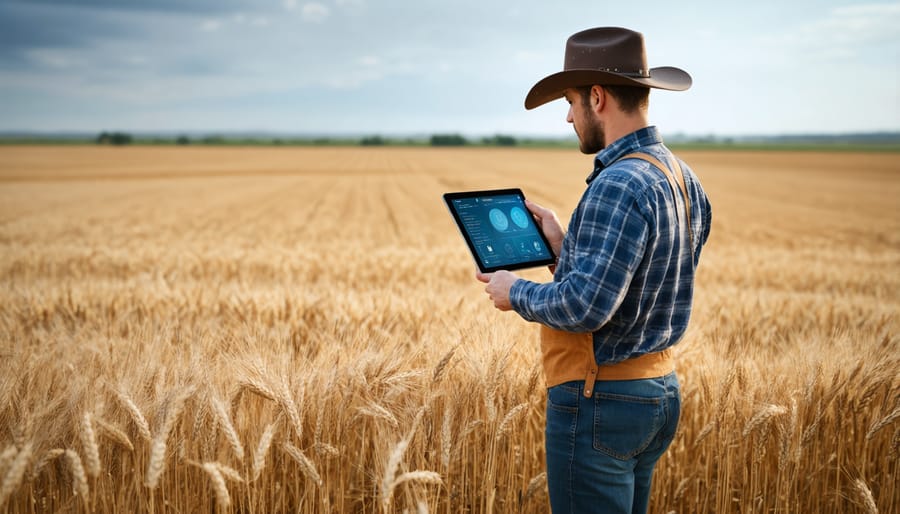
Real-Time Field-to-Table Tracking
Modern Canadian farms are revolutionizing their supply chains through AI-powered tracking systems that enable complete field-to-table traceability. By integrating IoT sensors throughout the journey of crops, farmers can monitor crucial data points like temperature, humidity, and handling conditions in real-time.
Here in Alberta, forward-thinking operations like Prairie Farms Cooperative have implemented smart tracking systems that use GPS-enabled sensors to monitor their grain shipments from harvest to processing. These sensors transmit data to AI systems that automatically alert stakeholders about potential issues, from moisture levels exceeding 14% to unexpected delays in transit.
The benefits are substantial: reduced food waste, improved quality control, and enhanced transparency for consumers. Local producer Sarah Thompson notes, “Since implementing IoT tracking, we’ve cut our transit losses by 30% and can now guarantee our customers precise delivery times and product quality.”
The system also helps maintain compliance with Canadian food safety regulations while providing valuable insights for optimizing routes and storage conditions. This technology is particularly valuable during our challenging prairie winters, ensuring produce remains fresh despite extreme temperature variations.
Reducing Food Waste Through Smart Prediction
In Alberta’s agricultural sector, AI-powered prediction systems are revolutionizing how we manage food waste, particularly in grain storage and produce distribution. Local farmers like Sarah Thompson from Red Deer have reported up to 25% reduction in produce waste after implementing smart prediction tools on their operations.
These AI systems analyze multiple data points, including historical sales patterns, weather forecasts, and local market trends, to help farmers and distributors make more accurate predictions about demand. For instance, the Southern Alberta Agricultural Co-op uses machine learning algorithms to forecast wheat demand, allowing members to optimize harvest timing and storage decisions.
The technology also helps in managing cold storage facilities more efficiently. By predicting optimal storage conditions and shelf life, farmers can better plan their distribution schedules. Calgary-based distributor Mountain Creek Farms reduced their waste by 30% in their first year using AI-powered inventory management.
For smaller operations, simple smartphone apps now offer accessible AI-powered planning tools. These solutions help track inventory levels and predict sales patterns, making smart prediction technology available to farms of all sizes across the province.
Smart Solutions for Sustainable Storage

Temperature and Humidity Control
Modern storage facilities across Alberta are increasingly adopting IoT-based monitoring systems to maintain optimal conditions for agricultural products. These smart systems use a network of sensors to continuously track temperature and humidity levels, ensuring crop quality while reducing energy consumption and waste.
At the Brown Family Farm near Lethbridge, temperature sensors placed throughout their grain storage facility communicate real-time data to a central AI system. “Since implementing these sensors, we’ve reduced our spoilage rates by 85% and our energy usage by 30%,” shares Sarah Brown, a third-generation farmer.
The AI algorithms analyze environmental patterns and automatically adjust ventilation and cooling systems to maintain ideal storage conditions. For grain storage, the system typically maintains temperatures between 15-20°C and relative humidity levels of 12-14%, adjusting these parameters based on specific crop requirements and external weather conditions.
These smart systems also send instant alerts to farmers’ mobile devices when conditions fall outside acceptable ranges, allowing for quick intervention. Many Alberta farmers are finding that this proactive approach not only preserves crop quality but also significantly reduces the energy needed for climate control.
The Prairie Agricultural Machinery Institute estimates that farms using IoT-based monitoring systems save an average of 25% on energy costs while extending produce shelf life by up to 40%. This technology represents a crucial step toward more sustainable agricultural practices, combining environmental benefits with improved operational efficiency.
Energy-Efficient Warehouse Management
In Alberta’s agricultural sector, warehouse management plays a crucial role in maintaining efficient supply chains and reducing environmental impact. AI-powered systems are revolutionizing how storage facilities operate, creating more energy-efficient agricultural operations across the province.
Smart sensors and AI algorithms work together to optimize temperature control, lighting, and ventilation systems based on real-time conditions and inventory levels. For example, the Olds Agricultural Society’s storage facility reduced its energy consumption by 35% after implementing AI-controlled climate management.
These systems automatically adjust cooling and heating based on outdoor temperatures and product requirements, ensuring optimal storage conditions while minimizing energy waste. Motion sensors integrate with AI to provide lighting only where and when needed, significantly reducing electricity usage during off-peak hours.
Local farmers are seeing remarkable results through automated inventory management. The system predicts storage needs and organizes products efficiently, reducing the time and energy spent on movement and retrieval. Calgary-based grain storage facilities report up to 40% reduction in equipment operation time through AI-optimized routing and scheduling.
For smaller operations, even basic AI implementations can make a difference. Simple smart thermostats and occupancy sensors can lead to 15-20% energy savings without significant infrastructure changes. These solutions are becoming increasingly accessible to farmers of all scales, making sustainable warehouse management a realistic goal for the entire agricultural community.
Transportation Intelligence
Route Optimization for Carbon Reduction
In Alberta’s vast agricultural landscape, smart route optimization is transforming how we move products from field to market while reducing our carbon footprint. AI-powered systems analyze multiple factors like distance, fuel consumption, and delivery windows to create the most efficient delivery routes possible.
Local success stories, like the Central Alberta Co-op’s implementation of AI route planning, demonstrate how these technologies can cut fuel consumption by up to 25% while maintaining timely deliveries. The system considers weather conditions, road accessibility, and even combines multiple deliveries into single trips when feasible.
For Canadian farmers, particularly those managing large operations, AI route optimization offers practical benefits beyond environmental impact. Calgary-based farmer Tom McKenzie reports saving nearly $12,000 in fuel costs during his first year using AI-powered delivery planning, while reducing his fleet’s emissions by approximately 30%.
These systems also help during peak harvest seasons by automatically adjusting routes based on real-time conditions. Whether you’re delivering to local markets or coordinating with grain elevators, the technology ensures your products reach their destination efficiently while minimizing environmental impact.
The technology continues to evolve, with new features including integration with weather forecasting and real-time traffic updates, making it increasingly valuable for our agricultural community.
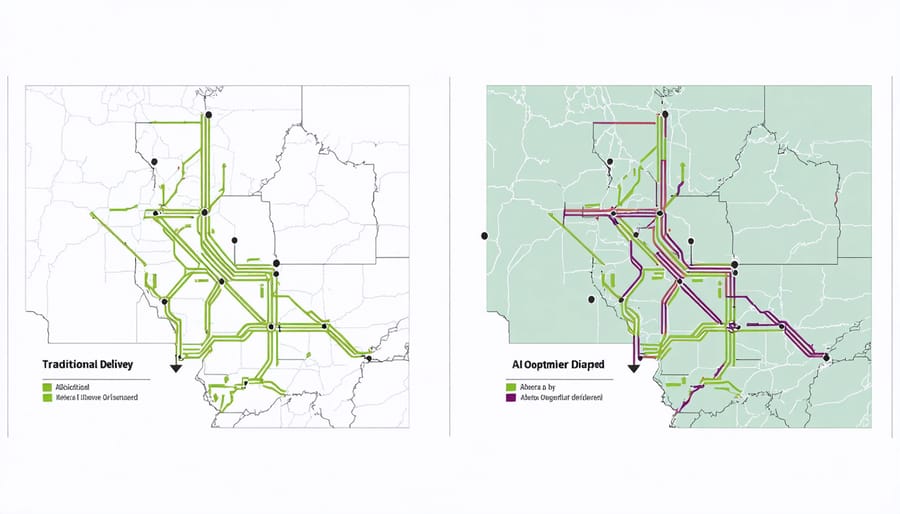
Cold Chain Monitoring
The integration of IoT sensors and AI technology in cold chain monitoring has revolutionized how we maintain product freshness during transport across Alberta’s vast agricultural landscape. These smart systems continuously track temperature, humidity, and other critical factors, ensuring that perishable goods remain at optimal conditions from farm to market.
For instance, at the McCarthy Family Farm near Lethbridge, wireless sensors installed in their refrigerated trucks transmit real-time data to a central monitoring system. This allows them to adjust storage conditions instantly, reducing produce spoilage by 23% in their first year of implementation.
The technology doesn’t just monitor – it predicts. AI algorithms analyze historical data patterns to forecast potential temperature fluctuations and equipment failures before they occur. This predictive capability has proven particularly valuable during Alberta’s extreme weather conditions, where temperature control is crucial for maintaining product quality.
Local producers are seeing tangible benefits: reduced energy consumption through optimized cooling cycles, decreased product waste, and enhanced compliance with food safety regulations. The system also generates detailed reports that help farmers make data-driven decisions about their transportation routes and storage practices, leading to more sustainable operations overall.
These smart monitoring solutions are becoming increasingly accessible to small and medium-sized farms, with several government programs offering support for implementation costs.
Getting Started with Smart Supply Chain Solutions
Cost-Effective Entry Points
Getting started with AI and sustainability doesn’t have to break the bank. Many Alberta farmers have found success by starting small and scaling up gradually. A great first step is implementing basic sensors for soil moisture monitoring, which typically cost between $200-500 per unit and can significantly reduce water usage.
Free or low-cost mobile apps are another excellent entry point. Several Canadian-developed applications help track crop health through smartphone cameras, providing valuable data without requiring expensive equipment. The Alberta Agricultural App, for instance, offers free weather monitoring and crop planning features.
Consider joining local farming cooperatives or agricultural technology sharing programs. These initiatives, common throughout Alberta, allow members to share costs and experience with AI-powered equipment. The Southern Alberta Smart Farm Initiative, for example, enables farmers to test advanced technologies before making significant investments.
Start with ready-to-use IoT kits designed specifically for agriculture. These starter packages, ranging from $1,000 to $2,500, typically include basic sensors, data collection tools, and user-friendly interfaces. Many local agricultural suppliers offer payment plans or seasonal pricing to make these more accessible.
Remember that government grants and sustainability incentives can help offset initial costs. The Canadian Agricultural Partnership program frequently provides funding for technology adoption, making it easier for farmers to embrace sustainable practices through AI implementation.
Building a Connected Farm Network
Building strong connections within your agricultural community is essential for maximizing the benefits of AI-driven sustainability initiatives. By establishing circular farming networks, Alberta farmers can share resources, data, and expertise while reducing operational costs.
Consider creating local farming clusters where neighboring operations can pool resources for AI implementation. For example, in the Red Deer region, a group of grain farmers shares weather station data and soil sensors, significantly reducing individual investment costs while improving collective decision-making.
Data sharing platforms have become invaluable tools for network building. The Southern Alberta Agricultural Research Initiative demonstrates how farmers can securely share crop yield data, irrigation patterns, and pest management strategies through cloud-based systems. This collaborative approach has helped participants reduce water usage by 25% and optimize resource allocation across connected farms.
To strengthen your network:
– Join local agricultural technology groups
– Participate in equipment-sharing programs
– Contribute to community data pools
– Attend regional AI farming workshops
– Partner with nearby farms for bulk technology purchases
Remember, successful networks start small and grow organically. Begin by connecting with two or three neighboring farms and gradually expand your circle as you develop trust and establish shared protocols for data management and resource sharing.
As we’ve explored throughout this article, AI technologies are revolutionizing sustainable agriculture across Alberta and Canada. The integration of smart farming solutions has already shown promising results, with many farmers reporting reduced water usage by up to 30% and decreased pesticide application by 20%. These improvements not only benefit our environment but also contribute to healthier bottom lines for farming operations.
Looking ahead, the future of sustainable agriculture in Alberta appears increasingly bright. With ongoing developments in machine learning and IoT sensors, we can expect even more precise and efficient farming practices. Many of our local agricultural experts predict that by 2025, AI-driven farming solutions will become standard practice across the province, helping us maintain our position as leaders in sustainable agriculture.
The key to success lies in our community’s willingness to embrace these innovations while maintaining our traditional farming wisdom. As more farmers share their success stories and experiences, we’re building a stronger, more sustainable agricultural sector together. Remember, every step toward AI-enhanced farming practices is a step toward securing our agricultural future for the next generation.
For those considering implementing AI solutions on their farms, our local agricultural extension offices and technology providers are ready to help you begin this journey. By working together and embracing these innovations, we can ensure that Canadian agriculture remains both profitable and environmentally responsible for years to come.


